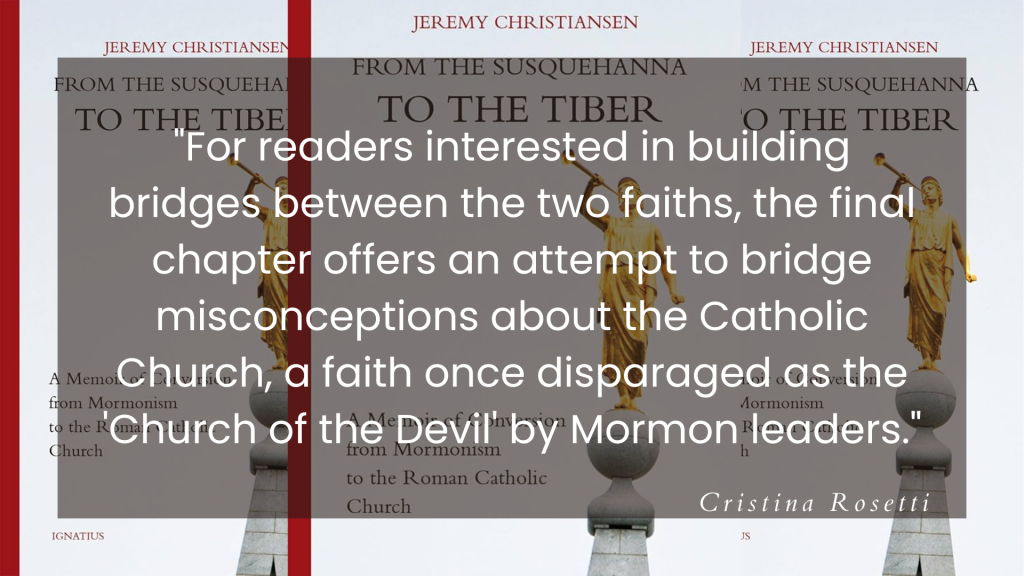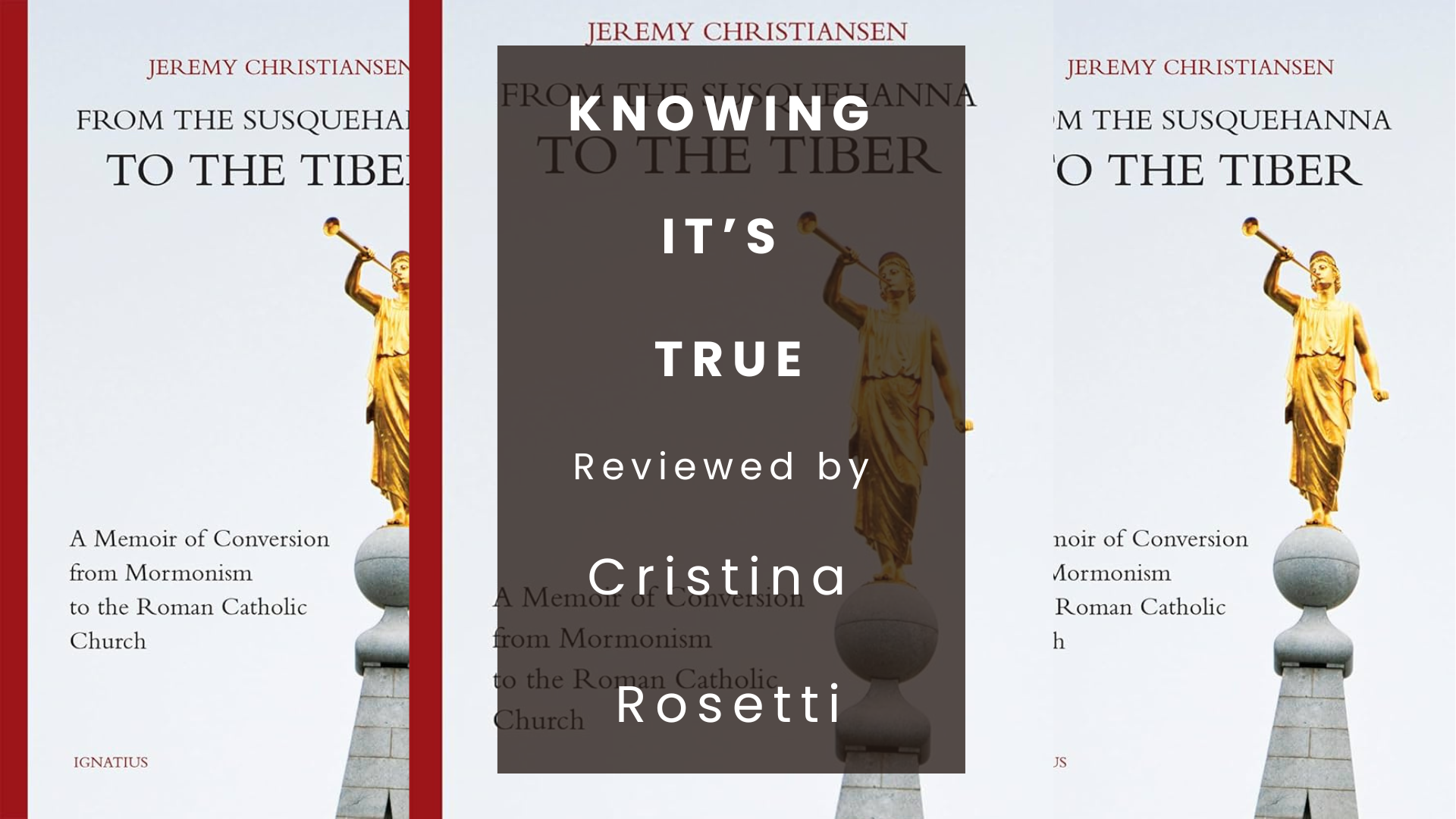Articles/Essays – Volume 57, No. 3
Knowing It’s True | Jeremy Christiansen, From the Susquehanna to the Tiber: A Memoir of Conversion from Mormonism to the Roman Catholic Church
“I am finally no longer asked to believe in things for which not only is there no evidence, but which the evidence strongly condemns on fair inspection. . . . Let me be clear: I believe in God, the Father almighty, Maker of heaven and earth, and of all things, visible and invisible” (240). The letter Jeremy Christiansen wrote to his bishop included the entire Nicene Creed, a prayer he learned while reading the history of Christianity and heard numerous times (in Latin) while attending Mass at Saint Rita Catholic Church in Alexandria, Virginia. At the time of this letter, Jeremy did not “know” the Catholic Church was true. Like millions of Catholics around the world, he nevertheless assented his will to it.
In the last ten years, books, documentaries, and television that center ex-Mormonism and faith transition have become common forms of entertainment. The stories usually cover similar themes and end with formal resignation from the Church’s membership records. In this way, Christiansen’s book, From the Susquehanna to the Tiber: A Memoir of Conversion from Mormonism to the Roman Catholic Church, is squarely within the ex-Mormon memoir genre. Christiansen was born in Blanding, Utah, and raised in a faithful family. While he had a lapse in adherence to Church standards during high school, he eventually served a mission in Argentina, married in the temple, and diligently served his ward during college and the early years of his legal career.
What makes the book different, however, is Christiansen’s entry into the Roman Catholic Church. The memoir is broken into three parts. The first covers his early years in Mormonism, high school experiences, gaining a Mormon testimony through a “burning in the bosom,” and two-year mission. The second part, “Dark Night of the Soul,” named after St. John of the Cross’s poem and the spiritual experience of many saints, covers his early moments of doubt. How could a blessing at the hands of a priesthood leader be wrong? Why were so many people leaving the Church? In this section, Christiansen outlines the specific historical issues that concerned him. These issues will be familiar to readers of Church history and ex-Mormon media: Book of Mormon translation and historicity, polygamy, and revisionism.

All of this led Christiansen down a Christian history rabbit hole, the final part of the memoir. This section includes a large swath of history from the Church Fathers. As Christiansen read Church history, he confronted a reality he had never considered: maybe the Great Apostasy never happened. Through the writings of the Church Fathers, he learned the early Church’s defense of the Eucharist, Trinitarian theology, and continuity of tradition. In each of these, he realized that his ideas about Catholicism were based on a caricature. In the writings of the Church Fathers, Christiansen found a faith that “appealed, for the first time any religion had done so, to my intellect” (227). All of this solidified Christiansen’s conviction. On the feast of St. Charles Borromeo, Archbishop of Milan and leading figure in the Counter-Reformation, he was welcomed into the Roman Catholic Church.
Throughout the memoir, the nature of a Mormon testimony develops as a central theme. At the onset, Christiansen explains that “You don’t just believe Mormonism. You know it is true” (21). Within Mormonism, “knowledge” of the truth is known emotively through “the simultaneous convergence of (1) an abstract truth proposition about the Mormon Church (for example, Joseph Smith was a true prophet, the Book of Mormon is the word of God) and (2) an overwhelming emotional sense of wellbeing. Occurring simultaneously these two things (concept and emotion) produce a powerful ‘aha!’ moment, leading to a sense that one now knows that abstract truth proposition in a distinct and even ineffable way” (24). This way of acquiring knowledge was the foundation of Christiansen’s faith. However, as he learned Mormon history and the history of Christianity, this foundation came into question. Feelings, for Christiansen, are shaky ground. A testimony, as he told his bishop, is “built almost entirely on emotion. It is subjective. It is fideism” (239).
Christiansen juxtaposes the Mormon testimony experience with his entry into Roman Catholicism. From the outset, he is clear that he did not “know” the Catholic Church was true, at least not in the same way as Mormonism. He explained, “I have not had any individual emotional experience that was God’s answer to my prayers” (239). For readers from a Mormon background, this might seem strange, but it is distinctly Catholic and an experience that resonates with my own conversion to Roman Catholicism. The faith Christiansen encountered in the Church Fathers spoke to his mind, not just his heart. Reading St. Thomas Aquinas’s “Five Ways” presented a way to “know” based on Aristotelian metaphysics and refutation of proposed objections. For Aquinas, “The knowledge of God is the cause of things.”[1]
For readers interested in building bridges between the two faiths, the final chapter offers an attempt to correct misconceptions about the Catholic Church, a faith once disparaged as the “Church of the Devil” by Mormon leaders (36). Christiansen explains that Catholic theology on the Trinity, Eucharist, and apostolic succession were things he only knew as caricatures prior to reading the Church Fathers. This chapter offers an overview of the essential writings on these topics, including citations to guide further reading.
Jeremy Christiansen’s memoir is a journey from one faith to another told with vulnerability and love. This book should be on the reading list of anyone interested in memoirs, faith transition, and interfaith dialogue. Christiansen is self-reflexive enough to recognize that the book might be uncomfortable or tragic to Mormon readers. To this response, he simply hopes readers will know he truly believed he had a testimony (247).
Jeremy Christiansen. From the Susquehanna to the Tiber: A Memoir of Conversion from Mormonism to the Roman Catholic Church. San Francisco: Ignatius Press, 2022. 250 pp. Paper: $17.95. ISBN: 9781621645924.
[1] Thomas Aquinas, Summa Theologiae I, Q14, A8.


 Back to full Issue
Back to full Issue

